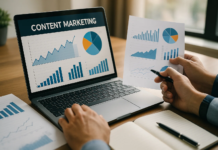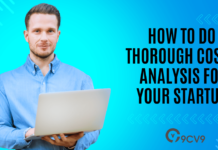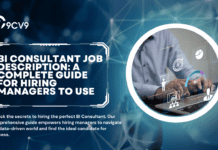Key Takeaways
- AI-powered analytics uses machine learning and automation to uncover deeper insights from large, complex data sets in real time.
- It enables predictive and prescriptive decision-making across industries like healthcare, finance, retail, and manufacturing.
- Businesses leveraging AI analytics gain competitive advantages through enhanced efficiency, personalization, and data-driven innovation.
In an era where data is rapidly becoming the most valuable asset for businesses, the ability to extract actionable insights from vast and complex datasets is no longer a luxury—it’s a necessity. Traditional analytics methods, while effective to a certain degree, are increasingly being challenged by the growing volume, velocity, and variety of data that organizations generate daily. This has led to the rise of AI-powered analytics, a revolutionary advancement that combines the power of artificial intelligence with data analysis to unlock deeper, more accurate, and faster insights than ever before.

AI-powered analytics refers to the integration of artificial intelligence technologies—such as machine learning, natural language processing (NLP), and predictive modeling—into the process of analyzing data. Unlike conventional analytics, which often rely heavily on manual input and static dashboards, AI-driven solutions are designed to autonomously process large data sets, identify patterns, make predictions, and even prescribe actions in real time. This level of intelligence enables organizations to make proactive, data-informed decisions with a higher degree of precision and agility.
From predicting customer behavior and optimizing supply chains to detecting fraud and forecasting financial trends, AI-powered analytics is transforming how businesses operate across virtually every industry. Whether it’s a global retail brand seeking to personalize the customer experience or a healthcare provider aiming to improve diagnostic accuracy, the application of AI in analytics is proving to be a game-changer in achieving operational excellence and strategic advantage.
One of the most compelling aspects of AI-powered analytics is its ability to handle both structured and unstructured data from multiple sources—including databases, social media, IoT sensors, and more. These systems continuously learn and adapt, improving their performance over time with each new data input. As a result, the insights generated become not only faster but also more contextually relevant and reliable.
Furthermore, the shift toward AI-driven insights is not just about speed or efficiency—it’s also about enabling business users to ask more complex questions and receive intelligible, data-backed answers. With the rise of natural language query capabilities and intelligent dashboards, AI-powered analytics is making advanced data science accessible to non-technical users, democratizing data-driven decision-making across organizations.
This blog explores what AI-powered analytics truly means, delves into the core technologies and processes behind it, and explains in detail how it works in practice. It will also examine the key benefits, use cases, challenges, and the future trajectory of this transformative innovation. As enterprises strive to become more agile, customer-centric, and future-ready, understanding AI-powered analytics is critical for staying ahead in a highly competitive digital landscape.
Whether you are a business leader, IT strategist, data professional, or simply an enthusiast of emerging technologies, this comprehensive guide will provide valuable insights into how AI is revolutionizing analytics—and why adopting it may be the key to unlocking unprecedented growth and innovation in the years to come.
Before we venture further into this article, we would like to share who we are and what we do.
About 9cv9
9cv9 is a business tech startup based in Singapore and Asia, with a strong presence all over the world.
With over nine years of startup and business experience, and being highly involved in connecting with thousands of companies and startups, the 9cv9 team has listed some important learning points in this overview of What is AI-powered analytics and How It Works.
If your company needs recruitment and headhunting services to hire top-quality employees, you can use 9cv9 headhunting and recruitment services to hire top talents and candidates. Find out more here, or send over an email to [email protected].
Or just post 1 free job posting here at 9cv9 Hiring Portal in under 10 minutes.
What is AI-powered analytics and How It Works
- What is AI-powered Analytics?
- How AI-powered Analytics Works
- Benefits of AI-powered Analytics
- Use Cases of AI-powered Analytics Across Industries
- Challenges and Limitations
- Future of AI-powered Analytics
1. What is AI-powered Analytics?
AI-powered analytics refers to the application of artificial intelligence technologies to the field of data analysis, allowing systems to automate, optimize, and enhance the process of discovering patterns, insights, and predictions from large and diverse datasets. It transforms raw data into strategic business intelligence using algorithms that learn, adapt, and improve over time.
Unlike traditional analytics, which typically depend on historical data and manual interpretation, AI-powered analytics is dynamic, context-aware, and capable of real-time decision-making.
Key Concepts and Definition
Definition:
- AI-powered analytics is the use of machine learning, natural language processing (NLP), deep learning, and automated decision-making technologies to analyze data.
- It aims to uncover hidden patterns, predict future outcomes, and automate complex analytical tasks.
Core Objectives:
- Automate data discovery and reporting
- Provide predictive and prescriptive insights
- Reduce human error in decision-making
- Enable real-time business intelligence
Core Technologies Behind AI-powered Analytics
1. Machine Learning (ML):
- Learns from data without explicit programming
- Builds models that improve with more data over time
- Example: Forecasting product demand based on seasonal trends
2. Natural Language Processing (NLP):
- Enables systems to interpret, process, and respond to human language
- Used in chatbots, voice assistants, and AI-driven reporting tools
- Example: Auto-generated performance summaries from business dashboards
3. Deep Learning:
- A subset of ML that uses neural networks to process data
- Ideal for complex datasets like images, video, or unstructured text
- Example: Analyzing medical images for early detection of disease
4. Computer Vision:
- AI that can interpret visual data
- Common in security, manufacturing, and retail analytics
- Example: Monitoring in-store customer movement patterns using cameras
Key Features of AI-powered Analytics
| Feature | Traditional Analytics | AI-powered Analytics |
|---|---|---|
| Data Processing Speed | Manual or semi-automated | Real-time, automated |
| Data Types Supported | Primarily structured | Structured and unstructured |
| Insight Generation | Descriptive, historical | Predictive and prescriptive |
| User Involvement | High (data scientists, analysts) | Low to moderate (AI handles bulk work) |
| Adaptability | Static dashboards | Self-learning, adaptive models |
| Decision Support | Reactive | Proactive and autonomous |
Types of AI-powered Analytics
1. Descriptive Analytics
- Purpose: Summarizes historical data to identify trends and patterns
- Example: Retailer identifying top-selling products over the past 6 months
2. Diagnostic Analytics
- Purpose: Analyzes data to determine why something happened
- Example: Analyzing reasons behind a sudden drop in website traffic
3. Predictive Analytics
- Purpose: Uses statistical models and ML to forecast future outcomes
- Example: Banks predicting the likelihood of loan default by customers
4. Prescriptive Analytics
- Purpose: Recommends actions based on data analysis
- Example: E-commerce platforms suggesting optimal discount strategies to boost conversions
Real-World Applications of AI-powered Analytics
Retail
- Personalized product recommendations based on browsing behavior
- Predicting inventory needs to reduce overstock and stockouts
- Sentiment analysis of customer reviews to improve service
Healthcare
- Predictive analytics to assess patient readmission risk
- Analyzing EMRs (Electronic Medical Records) using NLP
- Drug discovery using deep learning on molecular datasets
Finance
- Fraud detection using anomaly detection algorithms
- Real-time trading decisions using AI-powered bots
- Automated credit scoring using behavioral and transactional data
Manufacturing
- Predictive maintenance to avoid machine failures
- Quality control using image recognition
- Supply chain optimization with real-time demand forecasts
AI-powered Analytics vs Traditional Analytics: Key Differences
| Category | Traditional Analytics | AI-powered Analytics |
|---|---|---|
| Insight Type | Historical and backward-looking | Forward-looking and prescriptive |
| Data Input | Requires clean, structured data | Handles structured, semi-structured, and unstructured |
| Human Intervention | High—data analysts needed for interpretation | Low—AI handles interpretation and reporting |
| Decision-Making | Based on static reports | Dynamic, data-driven decisions in real-time |
| Learning Capability | None—static models | Continuous learning and model improvement |
Benefits of Using AI-powered Analytics
- Increased Speed and Efficiency: Automated data processing dramatically reduces time-to-insight
- Higher Accuracy: Reduced human error in complex data interpretation
- Actionable Predictions: Real-time forecasts enable agile responses to business needs
- Scalability: Easily handles big data environments with millions of data points
- Accessibility: Non-technical users can interact via AI-driven dashboards and natural language queries
2. How AI-powered Analytics Works
AI-powered analytics operates through a multi-layered process that integrates data acquisition, machine learning algorithms, predictive modeling, and real-time decision-making. The entire system is designed to process vast datasets, uncover hidden patterns, and recommend intelligent actions with minimal human intervention. It leverages technologies such as machine learning (ML), natural language processing (NLP), deep learning, and automationto offer scalable, dynamic, and insightful analytics across industries.
Step-by-Step Workflow of AI-powered Analytics
1. Data Collection and Ingestion
- Description: The process begins with gathering data from multiple sources.
- Sources include:
- Enterprise databases (SQL, NoSQL)
- Cloud storage systems
- IoT devices and sensors
- Social media platforms
- APIs and CRM/ERP systems
- Example: A retail chain pulls sales, customer feedback, and inventory data from its e-commerce site, in-store POS systems, and social media feeds.
2. Data Cleaning and Preparation
- Purpose: Ensures data quality and removes inconsistencies or noise before analysis.
- Processes involved:
- Data normalization
- Missing value imputation
- Data transformation (e.g., converting text to numeric values)
- Duplicate record removal
- Example: In healthcare analytics, patient medical histories from various hospitals are standardized into a uniform format for accurate diagnostics.
3. Data Integration and Storage
- Centralized repositories for storing processed data:
- Data warehouses (e.g., Snowflake, Amazon Redshift)
- Data lakes (e.g., Azure Data Lake, Hadoop HDFS)
- Hybrid architectures (for both structured and unstructured data)
- Purpose: Facilitates seamless access to data for analytics and modeling
- Example: A financial institution integrates transactional data with customer service logs into a centralized analytics platform.
4. Model Selection and Training (Machine Learning Phase)
- Algorithms are chosen based on the problem type:
- Regression models (for predicting continuous values)
- Classification models (for categorizing data points)
- Clustering algorithms (for customer segmentation)
- Recommendation engines (for personalizing offerings)
- Training process:
- Historical data is used to teach the algorithm
- The model learns to recognize patterns and correlations
- Example: An airline uses supervised learning to predict ticket pricing trends based on seasonal data and booking behavior.
Common Algorithms Used in AI-powered Analytics
| Algorithm Type | Examples | Use Case |
|---|---|---|
| Supervised Learning | Linear Regression, Decision Trees | Sales forecasting, risk assessment |
| Unsupervised Learning | K-Means, PCA | Customer segmentation, anomaly detection |
| Reinforcement Learning | Q-Learning, Deep Q-Networks | Dynamic pricing, robotic process optimization |
| Deep Learning | Convolutional Neural Networks (CNNs) | Image recognition, video analytics |
| NLP Models | BERT, GPT | Text summarization, sentiment analysis |
5. Model Validation and Testing
- Objective: Evaluate model performance on unseen data
- Techniques used:
- Cross-validation
- Confusion matrix
- ROC-AUC curves
- Mean Absolute Error (MAE), RMSE
- Example: A logistics company validates its delivery time prediction model using real-world delivery records to ensure reliability.
6. Insight Generation and Visualization
- AI interprets analytical outputs and converts them into human-readable insights
- Tools involved:
- BI dashboards (Power BI, Tableau)
- NLP-powered interfaces (chatbots or AI assistants)
- Automated reports and alerts
- Example: An e-commerce business uses an AI dashboard that automatically highlights underperforming products and suggests price adjustments.
7. Real-time Decision Making and Automation
- Prescriptive analytics guides next best actions
- Systems can be configured for real-time automation:
- Triggering marketing campaigns based on customer behavior
- Adjusting manufacturing line settings based on sensor data
- Automatically flagging and halting fraudulent transactions
- Example: A fintech company’s AI engine blocks suspicious transactions in real-time, reducing fraud losses.
Illustrative Architecture of AI-powered Analytics Workflow
Below is a textual representation of a typical AI-powered analytics architecture:
[Data Sources] → [ETL Pipelines] → [Data Lake/Data Warehouse] → [Model Training & Testing (ML/AI)]
→ [Analytics Engine] → [Dashboards/API Automation/NLP Interface] → [Business Decisions]
Explanation of Components:
- ETL Pipelines: Extract, Transform, Load processes for preparing raw data
- Analytics Engine: Core AI/ML logic performing predictions, anomaly detection, etc.
- Dashboards & APIs: Tools for user interaction and system-to-system communication
Real-World Examples of AI-powered Analytics in Action
1. Healthcare
- AI analyzes EMR data to detect early signs of chronic illnesses
- Predicts patient no-shows to optimize appointment scheduling
2. Retail
- Real-time price optimization based on competitor and demand analysis
- Automated recommendations based on purchase history and behavior
3. Manufacturing
- Predictive maintenance using sensor data to forecast equipment failure
- Quality control using computer vision and deep learning
4. Finance
- Credit risk scoring using behavioral data
- Fraud detection through anomaly detection models and pattern recognition
Integration with Business Processes
1. Embedded AI within ERP/CRM Systems
- AI modules are integrated into tools like Salesforce, SAP, and HubSpot
- Automates sales forecasting, churn prediction, and lead scoring
2. Cloud-based AI Analytics Platforms
- Platforms like AWS SageMaker, Azure Synapse Analytics, and Google Vertex AI offer end-to-end pipelines
- Highly scalable and cost-efficient for large enterprises
Challenges Addressed by the Working Mechanism
- Volume: AI handles petabytes of data across different formats and speeds
- Velocity: Processes streaming data in real time for instant decision-making
- Variety: Works with structured, semi-structured, and unstructured data
- Veracity: Improves data reliability through automated anomaly detection
- Value: Extracts high-impact insights that drive ROI
3. Benefits of AI-powered Analytics
AI-powered analytics delivers transformational value across industries by enabling faster, smarter, and more scalable decision-making. By leveraging advanced technologies such as machine learning, natural language processing (NLP), and automation, businesses can extract actionable insights, reduce operational costs, and unlock competitive advantages.
1. Enhanced Data-Driven Decision Making
Key Benefits:
- Provides faster and more accurate insights from large, complex datasets
- Eliminates guesswork by revealing hidden patterns, correlations, and trends
- Supports evidence-based strategy formation across departments
Examples:
- A global logistics firm uses AI analytics to determine optimal shipping routes and inventory stocking levels, reducing delivery delays by 23%
- Healthcare providers use predictive analytics to recommend personalized treatment plans based on patient histories and outcomes
2. Real-time Insights and Predictive Capabilities
Key Benefits:
- Processes live data streams to offer real-time dashboards and alerts
- Predicts future outcomes such as demand spikes, customer churn, or equipment failures
- Improves responsiveness to market or operational changes
Examples:
- A fintech company detects fraudulent transactions within milliseconds using anomaly detection models
- E-commerce platforms predict when a customer is likely to abandon their cart and trigger immediate promotional offers to retain sales
Use Case Comparison Table:
| Industry | Real-time Use Case | Predictive Benefit |
|---|---|---|
| Retail | Price adjustment based on competitor data | Forecast product demand and avoid overstocking |
| Healthcare | Patient monitoring with wearable devices | Predict disease risk and suggest early intervention |
| Manufacturing | IoT sensor data for equipment monitoring | Predict machine failures to schedule maintenance |
3. Improved Operational Efficiency
Key Benefits:
- Automates routine tasks like data cleansing, reporting, and anomaly detection
- Reduces manual effort and human error
- Speeds up processes through smart workflows and AI-driven automation
Examples:
- A telecom company reduces customer service response time by using NLP-powered chatbots
- AI-powered supply chain platforms automate procurement, demand forecasting, and logistics planning
4. Better Customer Experience and Personalization
Key Benefits:
- Delivers hyper-personalized recommendations based on individual behavior and preferences
- Predicts customer needs and proactively offers solutions
- Reduces churn by analyzing customer sentiment and usage patterns
Examples:
- Netflix recommends shows using AI models trained on viewer behavior and engagement metrics
- Banks use AI analytics to offer customized loan options based on credit history and transaction behavior
Sample Personalization Impact Table:
| Sector | AI-powered Action | Customer Benefit |
|---|---|---|
| Streaming Services | Personalized content curation | Increased user engagement and satisfaction |
| E-commerce | Tailored product recommendations | Higher conversion rates |
| Banking | Customized investment advice via robo-advisors | Better financial planning and user retention |
5. Increased ROI and Cost Reduction
Key Benefits:
- Optimizes resource allocation and reduces wastage
- Minimizes financial losses by detecting fraud or risk early
- Increases marketing ROI through targeted campaigns
Examples:
- Retailers reduce return rates by recommending better-fitting products using AI sizing guides
- Insurance firms flag fraudulent claims before they are paid out, saving millions annually
6. Competitive Advantage Through Innovation
Key Benefits:
- Accelerates product development with data-backed design and testing
- Drives innovation in services, features, and customer engagement models
- Creates differentiation by leveraging proprietary insights
Examples:
- Automotive companies use AI-powered analytics to refine autonomous driving algorithms
- Airlines optimize dynamic ticket pricing to stay competitive in fluctuating markets
7. Scalability and Flexibility Across Industries
Key Benefits:
- Applies across multiple domains, from healthcare to finance to manufacturing
- Adapts to growing datasets without compromising speed or accuracy
- Easily integrates with existing IT ecosystems (via APIs or cloud-based platforms)
Examples:
- A SaaS business uses AI analytics across departments—sales, marketing, and support—to create a 360-degree customer profile
- Government agencies utilize scalable AI solutions for traffic prediction and public safety insights
Scalability Impact Chart (Textual Description):
AI Complexity Level →
| |
Data Volume ↑ Rule-based → Machine Learning → Deep Learning
| (Linear Scalability → Non-linear Scalability)
|
Low → Mid-sized Business → Enterprise Platforms → Global Operations
8. Faster Time to Market
Key Benefits:
- Accelerates analytical processing from hours/days to minutes
- Improves decision-making cycles
- Speeds up product launches and market response
Examples:
- A consumer goods company uses AI to analyze market trends and launch seasonal promotions in real time
- Financial analysts use AI models to evaluate stock movements and execute trades faster than human-led analysis
9. Data Democratization and Self-service Analytics
Key Benefits:
- Empowers non-technical users to generate insights via drag-and-drop interfaces or natural language queries
- Reduces dependency on IT teams
- Fosters a culture of data-driven thinking across the organization
Examples:
- Marketing managers use self-service dashboards to test campaign effectiveness without involving data scientists
- HR departments leverage AI to forecast hiring needs and employee turnover without technical training
10. Enhanced Risk Management and Compliance
Key Benefits:
- Identifies risks proactively through anomaly detection and predictive models
- Supports regulatory compliance by automatically flagging suspicious behavior or inconsistencies
- Improves audit readiness with traceable AI-driven documentation
Examples:
- Banks use AI to monitor KYC (Know Your Customer) compliance and detect money laundering patterns
- Pharmaceutical firms apply AI to monitor clinical trial adherence and regulatory reporting
Summary Table: Core Benefits of AI-powered Analytics by Function
| Business Function | AI-powered Benefit | Example Use Case |
|---|---|---|
| Marketing | Campaign optimization, personalization | Real-time A/B testing, dynamic content suggestions |
| Operations | Process automation, efficiency | Smart scheduling, demand forecasting |
| Finance | Fraud detection, ROI tracking | Anomaly detection in spending |
| Sales | Lead scoring, sales prediction | Predictive sales modeling |
| HR | Attrition prediction, talent acquisition | AI-driven screening and engagement analysis |
| Customer Support | NLP-based automation, satisfaction analysis | AI chatbots, sentiment tracking |
4. Use Cases of AI-powered Analytics Across Industries
AI-powered analytics has found transformative applications across multiple industries, empowering organizations to convert raw data into intelligent, actionable insights. From forecasting customer behavior in retail to enabling precision diagnostics in healthcare, AI analytics is revolutionizing traditional operational models with automation, speed, and accuracy.
1. AI-powered Analytics in Healthcare
Key Use Cases:
- Predictive Diagnostics
- AI models analyze medical histories and lab results to forecast the risk of chronic diseases like diabetes, heart disease, or cancer.
- Hospitals use machine learning to identify sepsis or stroke symptoms early, reducing mortality rates.
- Medical Imaging and Radiology
- Computer vision algorithms detect anomalies in X-rays, MRIs, and CT scans.
- Enhances diagnostic accuracy and reduces workload for radiologists.
- Operational Efficiency
- Predicts patient admission rates and optimizes staff and resource allocation.
- Improves scheduling and reduces emergency room wait times.
Real-World Example:
- IBM Watson Health applies AI analytics to assist oncologists in identifying the most effective cancer treatment options based on patient profiles and global medical research.
Healthcare Analytics Benefits Table:
| Use Case | AI Benefit | Impact |
|---|---|---|
| Predictive Diagnostics | Early disease detection | Reduced hospitalization |
| Radiology Assistance | Image anomaly detection | Faster, accurate diagnosis |
| Patient Flow Mgmt | Real-time admission/discharge trends | Operational cost reduction |
2. AI-powered Analytics in Retail and E-commerce
Key Use Cases:
- Personalized Product Recommendations
- Analyzes customer behavior, preferences, and purchase history.
- Recommends products that increase average order value and conversions.
- Dynamic Pricing Optimization
- Adjusts prices based on demand trends, competitor data, and inventory levels.
- Boosts revenue through real-time pricing strategies.
- Inventory Management
- Forecasts demand spikes and inventory turnover using historical and seasonal data.
- Prevents overstocking and stockouts.
Real-World Example:
- Amazon leverages AI-powered analytics to personalize the homepage for each customer, predict inventory needs, and recommend products.
Retail Use Case Table:
| Function | AI Application | Benefit |
|---|---|---|
| Product Discovery | Personalized recommendations | Increased conversions |
| Pricing Strategy | Real-time dynamic pricing | Revenue optimization |
| Inventory Planning | Predictive demand forecasting | Lower holding costs |
3. AI-powered Analytics in Financial Services
Key Use Cases:
- Fraud Detection
- AI models identify suspicious transaction patterns and block fraud in real-time.
- Behavioral biometrics are used to flag unusual user actions.
- Credit Risk Assessment
- Analyzes alternative data sources like utility bills, transaction history, and even social signals to assess loan risk.
- Algorithmic Trading
- AI detects market signals, news trends, and sentiment to optimize investment strategies.
Real-World Example:
- JP Morgan Chase uses AI to analyze legal documents and detect fraudulent trading patterns, saving thousands of man-hours annually.
Finance Use Case Table:
| Function | AI Use Case | Impact |
|---|---|---|
| Fraud Management | Real-time anomaly detection | Reduced financial loss |
| Credit Scoring | Alternative data analysis | Increased financial inclusion |
| Investment Strategy | AI-driven market prediction | Improved portfolio performance |
4. AI-powered Analytics in Manufacturing
Key Use Cases:
- Predictive Maintenance
- Sensors track machinery performance in real time to predict failures before they occur.
- Minimizes downtime and extends equipment life.
- Quality Control
- AI uses computer vision to inspect products for defects.
- Ensures consistent product quality and reduces recalls.
- Supply Chain Optimization
- Analyzes supplier performance, logistics, and demand patterns.
- Enhances procurement, warehousing, and distribution efficiency.
Real-World Example:
- Siemens uses AI analytics to detect performance anomalies in turbines and recommend timely maintenance.
Manufacturing Use Case Table:
| Area | AI Use Case | Operational Impact |
|---|---|---|
| Equipment Maintenance | Predictive failure detection | Reduced unplanned downtime |
| Product Inspection | Automated defect recognition | Higher production quality |
| Supply Chain | Demand and logistics optimization | Lower costs, faster delivery |
5. AI-powered Analytics in Marketing and Sales
Key Use Cases:
- Customer Segmentation
- Groups audiences based on demographics, behavior, and purchasing history.
- Allows for hyper-targeted marketing campaigns.
- Lead Scoring and Conversion Prediction
- Predicts which leads are most likely to convert based on interaction data.
- Optimizes sales team efforts.
- Campaign Performance Analysis
- Monitors real-time engagement across channels and adjusts strategies dynamically.
Real-World Example:
- Salesforce Einstein integrates AI to score leads and suggest next-best actions, improving sales funnel efficiency.
Marketing & Sales Analytics Table:
| Marketing Focus | AI-driven Solution | Business Outcome |
|---|---|---|
| Lead Management | Predictive lead scoring | Improved conversion rates |
| Audience Targeting | AI-based segmentation | Better campaign ROI |
| Content Optimization | Real-time performance analysis | Reduced ad spend waste |
6. AI-powered Analytics in Transportation and Logistics
Key Use Cases:
- Route Optimization
- Real-time traffic, weather, and vehicle data are used to find the most efficient routes.
- Fleet Management
- Tracks fuel consumption, driver behavior, and maintenance schedules.
- Demand Forecasting
- Predicts delivery volumes and adjusts operations accordingly.
Real-World Example:
- UPS leverages AI to optimize delivery routes, saving millions of gallons of fuel annually and reducing delivery times.
Transportation Use Case Table:
| Function | AI Use Case | Efficiency Gain |
|---|---|---|
| Routing | Real-time optimization | Faster deliveries, lower fuel usage |
| Fleet Operations | Predictive maintenance and tracking | Lower vehicle downtime |
| Demand Planning | Load forecasting | Balanced capacity planning |
7. AI-powered Analytics in Energy and Utilities
Key Use Cases:
- Smart Grid Management
- Monitors and predicts energy consumption patterns to balance supply and demand.
- Preventive Maintenance
- Identifies vulnerabilities in infrastructure to avoid blackouts or equipment failure.
- Renewable Energy Forecasting
- Predicts solar and wind energy production based on weather patterns.
Real-World Example:
- GE Digital uses AI analytics to manage wind turbines and improve energy output while reducing maintenance costs.
Energy Use Case Table:
| Segment | AI Use Case | Sustainability Outcome |
|---|---|---|
| Power Distribution | Load prediction and balancing | Energy efficiency |
| Equipment Monitoring | Real-time failure prediction | Less downtime, safer operations |
| Renewable Integration | Forecasting output variability | Improved reliability of green energy |
8. AI-powered Analytics in Education
Key Use Cases:
- Student Performance Prediction
- Identifies students at risk of failing or dropping out and recommends interventions.
- Curriculum Personalization
- Adapts course materials based on individual learning speed and style.
- Operational Efficiency
- Forecasts classroom resource needs and scheduling optimization.
Real-World Example:
- Coursera uses AI to recommend learning paths and courses based on user behavior and goals.
Education Analytics Table:
| Focus Area | AI Capability | Impact on Learning |
|---|---|---|
| Student Monitoring | Predict academic outcomes | Targeted interventions |
| Course Delivery | Personalized content recommendations | Improved engagement |
| Admin Operations | Resource and schedule prediction | Operational streamlining |
Summary Table: Cross-Industry AI Analytics Use Cases
| Industry | Primary AI Use Case | Key Benefit |
|---|---|---|
| Healthcare | Predictive diagnostics, imaging | Early treatment, cost reduction |
| Retail | Personalized marketing, inventory control | Higher sales, better stock efficiency |
| Finance | Fraud detection, risk analytics | Risk mitigation, faster decisions |
| Manufacturing | Predictive maintenance, QC | Operational efficiency, quality control |
| Marketing & Sales | Lead scoring, campaign optimization | Better ROI, conversion uplift |
| Transportation | Route optimization, fleet management | Fuel savings, faster deliveries |
| Energy | Smart grids, renewable forecasting | Sustainability, balanced energy supply |
| Education | Student success analytics | Higher graduation rates, better outcomes |
5. Challenges and Limitations
Despite the transformative potential of AI-powered analytics, its implementation across various industries is accompanied by several challenges and limitations. These issues span data quality, ethical considerations, algorithmic biases, and integration difficulties, which can hinder organizations from fully realizing the value of AI-driven insights.
1. Data Quality and Availability Issues
Challenges:
- Incomplete or Inconsistent Data
- AI models depend heavily on high-quality, structured data.
- Missing values, data redundancy, or inconsistent formatting reduce model accuracy.
- Data Silos Across Departments
- Organizations often store data in isolated systems that don’t communicate.
- Hinders the formation of a unified analytics strategy.
- Limited Historical Data
- New businesses or sectors with limited digital footprints may not have sufficient training data for accurate modeling.
Example:
- A retail company implementing AI-based demand forecasting may face inaccuracies due to missing sales data from prior seasonal periods.
Data Quality Risk Table:
| Data Issue | Impact on AI Analytics |
|---|---|
| Incomplete Records | Poor model predictions |
| Siloed Systems | Fragmented analysis |
| Unstructured Text Data | Needs complex preprocessing |
2. Algorithmic Bias and Fairness
Challenges:
- Biased Training Data
- Historical biases (e.g., racial or gender discrimination) embedded in training data lead to biased predictions.
- Lack of Diverse Datasets
- Models trained on limited population groups fail to generalize across different regions or demographics.
- Ethical Concerns in High-Stakes Domains
- In healthcare and finance, biased AI outcomes can lead to unethical and sometimes illegal decisions.
Example:
- A recruitment platform using AI to screen resumes may favor male candidates if the historical hiring data reflects gender biases.
Fairness and Bias Risk Table:
| Domain | Bias Example | Potential Impact |
|---|---|---|
| HR Recruitment | Gender or ethnic name preferences | Discriminatory hiring practices |
| Lending/Finance | Credit score linked to zip codes | Redlining or biased loan denials |
| Healthcare | Underserved populations underrepresented | Unequal treatment or risk stratification |
3. Lack of Skilled Talent and Expertise
Challenges:
- Shortage of Qualified Data Scientists
- Difficulty in hiring professionals with strong AI, ML, and data engineering backgrounds.
- Limited Domain Expertise
- Data teams may lack industry-specific knowledge, leading to misinterpretation of patterns or incorrect model assumptions.
- Inadequate Training Resources
- Organizations struggle to upskill existing employees in AI tools and platforms.
Example:
- A logistics firm may deploy predictive analytics tools but fail to generate valuable insights due to misalignment between tech teams and fleet managers.
Talent Gap Risk Table:
| Problem Area | Effect on Analytics |
|---|---|
| Data Scientist Shortage | Slower implementation and tuning |
| Domain Skill Deficit | Poor business relevance of insights |
| Training Constraints | Inconsistent adoption across departments |
4. High Implementation and Maintenance Costs
Challenges:
- Infrastructure Investment
- Significant capital is required for cloud services, data storage, and computing power.
- Ongoing Maintenance
- AI models require continuous monitoring, retraining, and updating.
- Licensing and Vendor Lock-In
- Many proprietary AI analytics platforms come with costly licenses and limited customization.
Example:
- Small and mid-sized enterprises (SMEs) often find it unaffordable to implement enterprise-level AI analytics platforms like IBM Watson or SAS Viya.
Cost Breakdown Table:
| Expense Area | Typical Costs |
|---|---|
| Data Infrastructure | $50,000–$500,000 (initial setup) |
| AI Platform Licensing | $10,000+/month |
| Model Maintenance | Continuous human oversight and updates |
5. Interpretability and Explainability Challenges
Challenges:
- Black Box Models
- Deep learning and ensemble models are often opaque and hard to interpret.
- Regulatory Compliance
- Industries like healthcare, finance, and insurance require explainable decisions under laws such as GDPR or HIPAA.
- Stakeholder Trust
- Decision-makers are reluctant to act on insights they cannot understand or justify.
Example:
- A bank using AI for loan approvals may reject an application, but cannot provide a clear explanation to regulators or the applicant.
Interpretability Challenge Table:
| Model Type | Explainability Level | Suitability in Regulated Sectors |
|---|---|---|
| Decision Trees | High | Suitable |
| Neural Networks | Low | High risk unless explainability tools used |
| Gradient Boosting | Medium | Needs supplemental interpretability tools |
6. Data Security and Privacy Concerns
Challenges:
- Sensitive Data Exposure
- Medical records, financial data, and user behavior are highly confidential.
- Cybersecurity Risks
- AI systems are targets for adversarial attacks and data breaches.
- Regulatory Restrictions
- Global laws like GDPR, CCPA, and HIPAA restrict how personal data can be collected, stored, and analyzed.
Example:
- A healthcare analytics platform using AI must anonymize patient data while still retaining accuracy for diagnosis, which can be technically challenging.
Data Privacy Risk Table:
| Risk Area | AI Limitation |
|---|---|
| Identity Disclosure | Requires advanced anonymization methods |
| Data Breaches | May compromise sensitive analytics models |
| Regulatory Non-Compliance | Leads to legal penalties and fines |
7. Integration with Legacy Systems
Challenges:
- Compatibility Issues
- Legacy systems often use outdated databases and formats incompatible with modern AI platforms.
- Data Migration Complexity
- Transferring large volumes of unstructured data to modern systems is time-consuming and risky.
- Operational Disruption
- Integration efforts can disrupt ongoing business operations if not properly managed.
Example:
- A manufacturing company may struggle to integrate AI analytics with legacy ERP systems used for inventory and supply chain management.
Integration Risk Table:
| Legacy Barrier | Effect on AI Analytics |
|---|---|
| Incompatible Formats | Increases preprocessing time |
| Manual Data Entry Systems | Reduces automation capability |
| Closed Architecture | Limits AI model deployment flexibility |
8. Model Drift and Performance Degradation
Challenges:
- Changing Data Patterns
- Models trained on outdated data may perform poorly on current trends (concept drift).
- External Variables
- Unanticipated events (e.g., COVID-19 pandemic) disrupt the validity of predictive models.
- Lack of Continuous Monitoring
- Without active performance tracking, models gradually lose effectiveness.
Example:
- A demand forecasting model trained on pre-pandemic data failed during COVID-19 due to sudden changes in consumer behavior.
Model Drift Table:
| Root Cause | Resulting Problem |
|---|---|
| Seasonality or Trend Shift | Inaccurate predictions |
| External Shocks | Total model breakdown |
| No Re-training Pipeline | Continuous performance decline |
9. Legal and Regulatory Barriers
Challenges:
- Strict Compliance Requirements
- AI systems in banking, healthcare, and insurance must adhere to strict legal standards.
- Cross-border Data Transfer Issues
- Multinational companies face challenges with data storage and processing regulations across different jurisdictions.
- Lack of AI-specific Laws
- In many countries, the absence of clear AI governance creates uncertainty.
Example:
- An insurance firm using AI analytics to price premiums may face scrutiny under anti-discrimination laws if the algorithms are not transparent.
Legal Challenge Table:
| Industry | AI Compliance Risk | Regulatory Pressure |
|---|---|---|
| Finance | Transparent credit scoring models | High |
| Healthcare | HIPAA-compliant data handling | Very High |
| E-commerce | GDPR-related customer data usage | Medium |
10. Resistance to Change and Organizational Silos
Challenges:
- Cultural Barriers
- Resistance from employees or leadership who distrust automation or fear job loss.
- Lack of Cross-functional Collaboration
- Data teams, business units, and IT often work in silos, impeding holistic implementation.
- Misaligned Goals
- Stakeholders may not agree on the objectives and ROI of AI initiatives.
Example:
- In a healthcare institution, clinicians may resist AI-driven diagnostic support tools due to trust issues or fear of obsolescence.
Cultural Resistance Table:
| Organizational Issue | Effect on AI Projects |
|---|---|
| Siloed Teams | Inconsistent deployment strategy |
| Lack of Buy-in | Project abandonment or delay |
| Miscommunication | Mismatched expectations and metrics |
Summary: AI-powered Analytics Challenges by Industry
| Industry | Key AI Limitation |
|---|---|
| Healthcare | Data privacy, regulatory compliance |
| Retail | Data silos, dynamic behavior shifts |
| Finance | Algorithmic bias, explainability |
| Manufacturing | Legacy systems, talent gaps |
| Marketing & Sales | Data quality, attribution ambiguity |
| Logistics | Real-time data dependency |
| Energy | Forecast model drift, grid integration limits |
| Education | Bias in performance prediction, lack of data |
6. Future of AI-powered Analytics
As organizations reap the benefits of AI‑powered analytics today, the future promises even deeper innovation with real-time edge processing, augmented intelligence, explainability, and autonomous AI agents. Here’s what lies ahead:
Edge and Real‑Time Analytics at Scale
- Edge AI integration
- Processing data directly on devices (e.g., IoT, mobile, sensors) significantly reduces latency.
- Especially critical in sectors like healthcare, manufacturing, and autonomous vehicles.
- IDC projects that 75% of enterprise data will be processed at the edge by 2025.
- Streaming and real-time analytics
- Businesses expect insights “now”—real-time detection is becoming the norm.
- Applications include fraud detection in finance, dynamic pricing in e-commerce, and patient alerts in healthcare.
Augmented Analytics and Democratization
- AI‑led self-service tools
- Low‑code/no‑code platforms let non‑technical users explore data and generate insights.
- Natural language interfaces enable business users to query dashboards in plain English.
- Empowered workforce
- “Citizen data scientists”—workers with limited AI skills—will drive 70% of analytics by 2025.
Explainable AI (XAI) and Ethical Transparency
- Trustworthy AI systems
- Industries under scrutiny (finance, healthcare) demand clarity on how AI makes decisions.
- Explainable AI tools (feature importance, model transparency dashboards) will become standard to meet regulations.
Hyper‑automation and AutoML
- Full pipeline automation
- AI will automate data ingestion, cleaning, modeling, and deployment—minimizing human involvement.
- Gartner predicts 30% cost reductions via hyper‑automation by 2030.
- Automated Machine Learning
- AutoML platforms will handle feature engineering, hyperparameter tuning, and model selection.
- Makes AI accessible even for organizations with limited data science expertise.
Agentic and Autonomous AI
- Emergence of AI agents
- Agentic AI systems will perform tasks independently—acting as “co‑pilots” or fully autonomous agents.
- Use cases include supply chain reordering, financial trading, and customer support.
- Strategic adoption
- Successful implementations require clear objectives, governance, and oversight to mitigate risks such as bias and system vulnerabilities.
Emerging Architectures: Data Fabric and Multi‑Cloud
- Data fabric architectures
- A unified data layer that connects legacy systems, clouds, and edge sources—eliminating silos.
- Enables seamless data access and governance across diverse environments.
- Multi-cloud ecosystems
- Hybrid deployments boost resilience, avoid vendor lock-in, and optimize computing cost.
- Allows workload flexibility and improved disaster recovery.
Synthetic Data, Quantum Computing & Causal AI
- Synthetic data
- Artificially generated datasets used to augment or preserve privacy in training AI models.
- Useful in sensitive industries like healthcare and finance.
- Quantum‑AI convergence
- Early quantum experiments (e.g., Google’s 70× speed‑ups) hint at transformative increases in processing power by 2025.
- Will impact complex optimization tasks in drug discovery, climate modeling, and logistics.
- Causal AI
- Moves beyond correlation to identify cause-and-effect relationships, enhancing decision robustness under novel conditions
Future Trends at a Glance: AI‑powered Analytics
| Trend | Impact | Example |
|---|---|---|
| Edge & real-time analytics | Immediate insights; instant response | IoT alerts in manufacturing; patient monitoring devices |
| Augmented analytics | Democratized AI adoption; broader decision making | Low-code dashboards; NLP queries |
| Explainable AI (XAI) | Trust, compliance, and transparency | Transparent loan decision tools in banking |
| Hyper‑automation & AutoML | Cost reduction; faster time-to-insight | Automated pipelines in marketing analytics |
| Agentic AI | Autonomous operations; next-level efficiency | AI-driven stock trading and automated reordering systems |
| Data fabric & multi-cloud | Unified data governance and operational flexibility | Cross-platform analytics in global enterprises |
| Synthetic & quantum AI | Future-ready processing; advanced model training | Pharmaceutical R&D; secure synthetic datasets |
| Causal AI | Robust decision models adaptable to changing causal structures | Policy impact analysis; marketing campaign evaluation |
Conclusion
AI-powered analytics represents a significant paradigm shift in the way organizations approach data-driven decision-making. Far beyond traditional business intelligence, it fuses advanced machine learning algorithms, natural language processing, and automation technologies to deliver deeper, faster, and more actionable insights. As the volume, velocity, and variety of data continue to grow, organizations that embrace AI-powered analytics are positioned to unlock competitive advantages, optimize operations, and innovate with precision.
Key Takeaways: Why AI-Powered Analytics Is a Game-Changer
- Automated Intelligence:
AI-powered systems enable real-time data processing, anomaly detection, and predictive forecasting without constant manual input. This allows companies to stay ahead of disruptions, improve forecasting accuracy, and reduce response times. - Scalability and Efficiency:
From financial institutions handling billions of transactions to logistics firms managing dynamic supply chains, AI-powered analytics can analyze large-scale datasets rapidly and with minimal human intervention. This scalability dramatically enhances operational efficiency. - Industry-Agnostic Impact:
Across healthcare, finance, retail, manufacturing, and marketing, AI-powered analytics is unlocking new opportunities:- In healthcare, predictive models help identify patient risks before symptoms emerge.
- In retail, AI tools analyze customer behavior to tailor recommendations and promotions.
- In manufacturing, predictive maintenance reduces downtime and extends equipment life.
- Informed Decision-Making:
Decision-makers benefit from advanced dashboards that combine prescriptive analytics with natural language queries and visualization tools. This improves clarity, speeds up strategic planning, and minimizes reliance on guesswork. - Personalization and Customer Experience:
AI analytics enables hyper-personalized experiences, optimizing engagement strategies and delivering value-driven content or services. Companies like Netflix, Amazon, and Spotify leverage these capabilities to enhance customer satisfaction and loyalty.
Looking Ahead: The Future of AI-Driven Analytics
The future of AI-powered analytics is rooted in increased autonomy, real-time insights, and ethical intelligence:
- Causal and Explainable AI: Organizations will increasingly demand transparency in AI decisions, especially in regulated industries such as healthcare and finance.
- Edge and Quantum Computing Integration: AI analytics will expand to edge devices, enabling localized decision-making, while quantum AI will solve complex, high-dimensional problems.
- Augmented Workforce and Democratized Insights: Self-service tools and natural language interfaces will empower employees at every level to engage with data without needing coding expertise.
Strategic Imperative for Organizations
Investing in AI-powered analytics is no longer optional—it’s a strategic imperative. Organizations that adopt these technologies gain an edge through:
- Enhanced responsiveness to market trends and customer needs
- Data-driven innovation cycles
- Improved agility in uncertain environments
However, the successful implementation of AI-powered analytics requires:
- High-quality, well-governed data
- Clear business goals tied to AI outcomes
- Ethical oversight and compliance with data privacy laws
- Continuous workforce training to adapt to AI-enhanced roles
Final Thoughts
AI-powered analytics is redefining what it means to be data-driven. It is not simply about collecting data—it’s about unlocking its full potential through intelligent systems that can learn, adapt, and evolve. By integrating AI into analytical workflows, organizations can gain deeper insights, make smarter decisions, and maintain a competitive edge in a digitally transforming world.
As industries across the globe accelerate their digital transformation journeys, those that embrace AI-powered analytics today will be the innovators, leaders, and disruptors of tomorrow.
If you find this article useful, why not share it with your hiring manager and C-level suite friends and also leave a nice comment below?
We, at the 9cv9 Research Team, strive to bring the latest and most meaningful data, guides, and statistics to your doorstep.
To get access to top-quality guides, click over to 9cv9 Blog.
People Also Ask
What is AI-powered analytics?
AI-powered analytics uses artificial intelligence to analyze complex data sets, uncover patterns, and generate insights for better decision-making.
How does AI-powered analytics work?
It processes data using algorithms, machine learning, and automation to identify trends, make predictions, and provide actionable insights.
What technologies are used in AI-powered analytics?
AI-powered analytics uses machine learning, natural language processing, data mining, and neural networks to analyze and interpret data.
What is the difference between traditional analytics and AI-powered analytics?
Traditional analytics relies on manual analysis, while AI-powered analytics automates insights generation using intelligent algorithms.
Why is AI-powered analytics important for businesses?
It helps businesses make faster, smarter decisions, optimize operations, and personalize customer experiences using real-time data.
Can AI-powered analytics predict future outcomes?
Yes, it uses predictive modeling to forecast trends, behaviors, and potential risks based on historical data patterns.
Which industries benefit from AI-powered analytics?
Industries like healthcare, finance, retail, manufacturing, logistics, and marketing benefit significantly from AI-powered analytics.
Is AI-powered analytics the same as business intelligence?
No, AI-powered analytics extends beyond traditional BI by offering automation, predictions, and real-time decision-making support.
What are the key features of AI-powered analytics tools?
Features include data automation, real-time dashboards, predictive insights, anomaly detection, and natural language querying.
How does AI improve data accuracy?
AI minimizes human error, detects anomalies, and continuously learns from new data to refine analysis accuracy over time.
What are the benefits of using AI-powered analytics?
It offers faster insights, better predictions, improved efficiency, data-driven strategies, and personalized customer interactions.
Can small businesses use AI-powered analytics?
Yes, many cloud-based and affordable tools make AI analytics accessible to small and medium-sized businesses.
How secure is AI-powered analytics?
Security depends on the platform used; most enterprise-grade tools include encryption, access control, and compliance protocols.
Is coding required to use AI-powered analytics?
Many platforms are user-friendly with no-code interfaces, though advanced customization may require technical skills.
What are some examples of AI-powered analytics tools?
Examples include IBM Watson Analytics, Google Cloud AI, Microsoft Azure AI, Tableau with Einstein AI, and SAS Viya.
How does AI-powered analytics help in marketing?
It analyzes customer behavior, segments audiences, forecasts trends, and optimizes campaigns for better engagement and ROI.
Can AI analytics be integrated with existing software?
Yes, most AI analytics tools offer APIs and connectors to integrate with CRMs, ERPs, and other business systems.
What are the challenges of using AI-powered analytics?
Challenges include data quality issues, integration complexity, high implementation costs, and a need for skilled personnel.
How does AI analytics assist in customer service?
It powers chatbots, automates responses, analyzes customer sentiment, and suggests personalized solutions in real time.
Is AI-powered analytics scalable for enterprise use?
Yes, it’s designed to scale with large data volumes, offering flexibility and speed for enterprise-level decision-making.
Can AI analytics work in real time?
Yes, many tools process streaming data to provide real-time insights and trigger immediate responses or alerts.
How does AI-powered analytics support healthcare?
It helps detect diseases early, personalize treatment plans, optimize hospital workflows, and analyze patient outcomes.
What kind of data does AI-powered analytics require?
It uses structured and unstructured data, including text, images, customer records, sensor data, and transactional logs.
What is predictive analytics in AI?
It’s a subset of AI analytics that forecasts future outcomes using machine learning models trained on historical data.
How does AI-powered analytics help in finance?
It detects fraud, forecasts market trends, assesses credit risk, and improves investment decision-making processes.
Are AI analytics tools expensive?
Costs vary; some enterprise tools are costly, while many cloud-based or SaaS options offer flexible pricing for all sizes.
What is prescriptive analytics in AI?
Prescriptive analytics recommends specific actions to achieve desired outcomes based on predictive models and simulations.
How does AI-powered analytics handle big data?
It efficiently processes massive volumes of data, uncovers hidden patterns, and scales across cloud infrastructures.
Will AI-powered analytics replace human analysts?
Not entirely; it enhances human capabilities by automating routine tasks, allowing analysts to focus on strategy.
What is the future of AI-powered analytics?
It will involve more automation, real-time decisioning, explainable AI, and seamless integration with enterprise systems.































![Writing A Good CV [6 Tips To Improve Your CV] 6 Tips To Improve Your CV](https://blog.9cv9.com/wp-content/uploads/2020/06/2020-06-02-2-100x70.png)


